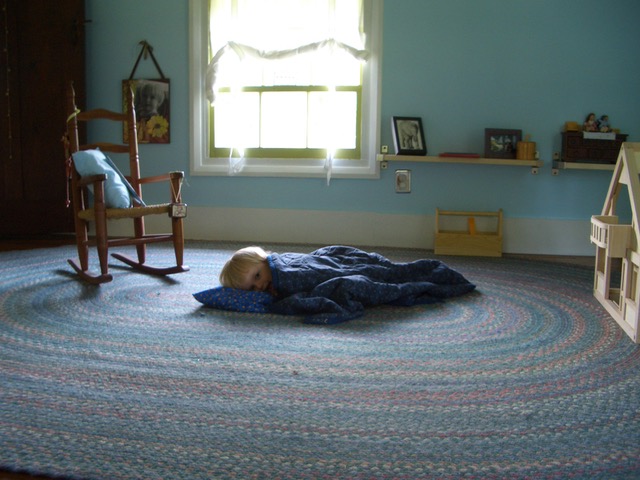 Let’s use this image for conversation. Here a young child, not yet three years old, rests spontaneously under a handmade small quilt, her head on a star fleeced pillow. Her rag rug of blues, peaches and pinks seems to surround her like an ebbing pool. The walls of her room are a pale blue, a soothing color especially chosen for the peaceful sense it provides. She has a nice low window with simple dress so that the sun can pour into her special space. She can operate the curtains easily, drawing them back each morning and closing them as the day ends. Her cherry wood rocking chair is perfectly fitted to her frame. The low shelf lining her wall is simple, at the right height, made of wood, and holds just a few items. There are two small framed photos, a treasure box, and a couple dolls from the near-by dollhouse resting on top. She has a wooden toolbox beneath the shelf and we can see that the electrical outlets are covered as a quiet reminder that these are not in use. The part of the bedroom we cannot see in this photo has a floor bed and a small armadio of three drawers, several shelves, and a short bar for hanging clothes. Storage of the child’s clothing needs to be at her height and a quantity that she can manage: a few shirts, two pairs of pants, night clothes, and under clothing all stored in separate drawers so that she can choose her clothing from all good options and she can stow her belongings independently. Her bed is small, a crib-size organic cotton and wool mattress resting in a handmade wooden frame. She can easily climb in and out of her bed independently. Functional independence: this early stage of child development has as its goal functional independence. How can the environment be prepared so that she can dress herself, tend to her belongings, tidy up, and most of all feel at home, at peace in her place?
Let’s use this image for conversation. Here a young child, not yet three years old, rests spontaneously under a handmade small quilt, her head on a star fleeced pillow. Her rag rug of blues, peaches and pinks seems to surround her like an ebbing pool. The walls of her room are a pale blue, a soothing color especially chosen for the peaceful sense it provides. She has a nice low window with simple dress so that the sun can pour into her special space. She can operate the curtains easily, drawing them back each morning and closing them as the day ends. Her cherry wood rocking chair is perfectly fitted to her frame. The low shelf lining her wall is simple, at the right height, made of wood, and holds just a few items. There are two small framed photos, a treasure box, and a couple dolls from the near-by dollhouse resting on top. She has a wooden toolbox beneath the shelf and we can see that the electrical outlets are covered as a quiet reminder that these are not in use. The part of the bedroom we cannot see in this photo has a floor bed and a small armadio of three drawers, several shelves, and a short bar for hanging clothes. Storage of the child’s clothing needs to be at her height and a quantity that she can manage: a few shirts, two pairs of pants, night clothes, and under clothing all stored in separate drawers so that she can choose her clothing from all good options and she can stow her belongings independently. Her bed is small, a crib-size organic cotton and wool mattress resting in a handmade wooden frame. She can easily climb in and out of her bed independently. Functional independence: this early stage of child development has as its goal functional independence. How can the environment be prepared so that she can dress herself, tend to her belongings, tidy up, and most of all feel at home, at peace in her place?
In upcoming blogs there will be additional photos used as a way to illustrate guiding principles. In your home, it is your creation and when you imagine yourself to be the height of your child, look around, what do you see, is there an open path or barriers in your way of movement? Do you feel invited in or unsure how to move in the space? How we establish an environment speaks to the child and encourages certain behaviors. In a calm environment wherein each object is thoughtfully chosen, has a purpose and a place, a child knows intuitively how to proceed. She feels how special the space is and how lovingly it has been prepared. This loving preparation calls to the child for her respect and care in return. Learning to care for one’s own space is essential in the development of self-care, an other-regarding compassion and awareness, then ultimately care of the much larger shared environment of our planet.
Choosing the objects in your child’s room takes consideration. Choosing open-ended objects of natural materials beckons to the child’s desire to interact and explore. When we give children beautiful objects, we are telling her that we trust her with them. We know she can manage with a real tool, that she can take care of it, follow directions, and learn how to put it away after each use.
In a culture where there is abundance, it can be a challenge to teach a child how to take care, protect, and conserve. Keep these principles in mind as you determine what you want your child to have in her space.
- Beauty
- Order
- Purpose
- Simple, uncluttered
- At child’s eye level
Ask what message you want the environment to communicate to the child and then assess if this has been created or not.
Thank you for joining us here at the Heartmoor Farm Education Centre Family Life Enrichment Blog. Please visit again, and feel free to contact us if you’d like more information about creating a vibrant, nurturing home environment for children.

